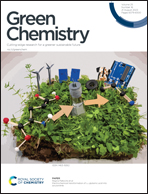Quantitative analysis of CO2 emissions reduction potential of alternative light olefins production processes†
Abstract
Approximately 400 Mt CO2 are emitted each year in the production of light olefins. Steam cracking of fossil feedstock is the predominant technology to produce ethylene and propylene, emitting around 1 t CO2 per t light olefins. Most of these emissions result from the combustion of fuels to provide the required high-temperature reaction heat. Low-carbon technologies will need to be implemented to produce these light olefins. In this study, we compare the CO2 emissions reduction potential (ERP) and electricity requirements of several of these alternative technologies. Steam crackers with electrical furnaces are limited to avoiding combustion-related CO2 emissions and can achieve a maximum CO2 emissions reduction of 92%. Replacement of fossil-based feedstock with CO2 can achieve much larger CO2 emissions reductions but requires five times more electricity. Four CO2-to-olefins routes were evaluated: H2O electrolysis coupled with (i) direct CO2 hydrogenation to olefins (C2O), or with (ii) CO2 hydrogenation to methanol coupled with methanol-to-olefins (C2M + MTO); and CO2 and H2O co-electrolysis to syngas coupled with (iii) CO hydrogenation to olefins (COhyd) or with (iv) Fischer–Tropsch synthesis (FTO). C2O and C2M + MTO show a similar CO2 ERP of −2.98 t CO2 per t olefins for an electricity requirement of 16 MW h t−1 olefins. Both routes outperform the CO-based routes. C2O requires a multi-step separation to recover the light olefins, yet it requires less cooling water and exports more excess steam than C2M + MTO. The latter requires additional gas compression and an energy-intensive methanol–water distillation step. Heat integration between the hydrogenation reactions and Solid–Oxide (SO) electrolysis reduces electricity requirements by 20% compared to Proton Exchange Membrane (PEM) electrolysis.



 Please wait while we load your content...
Please wait while we load your content...